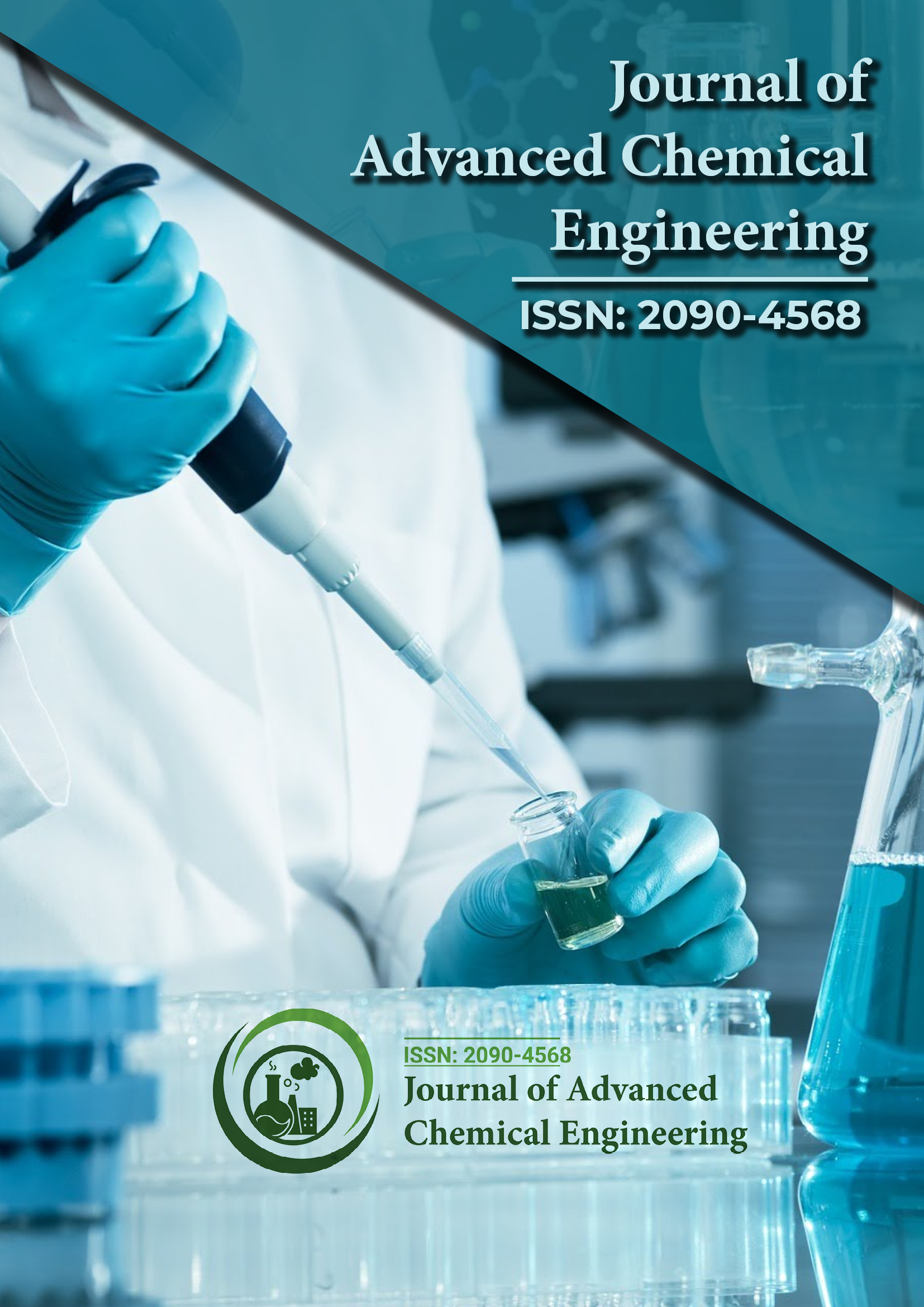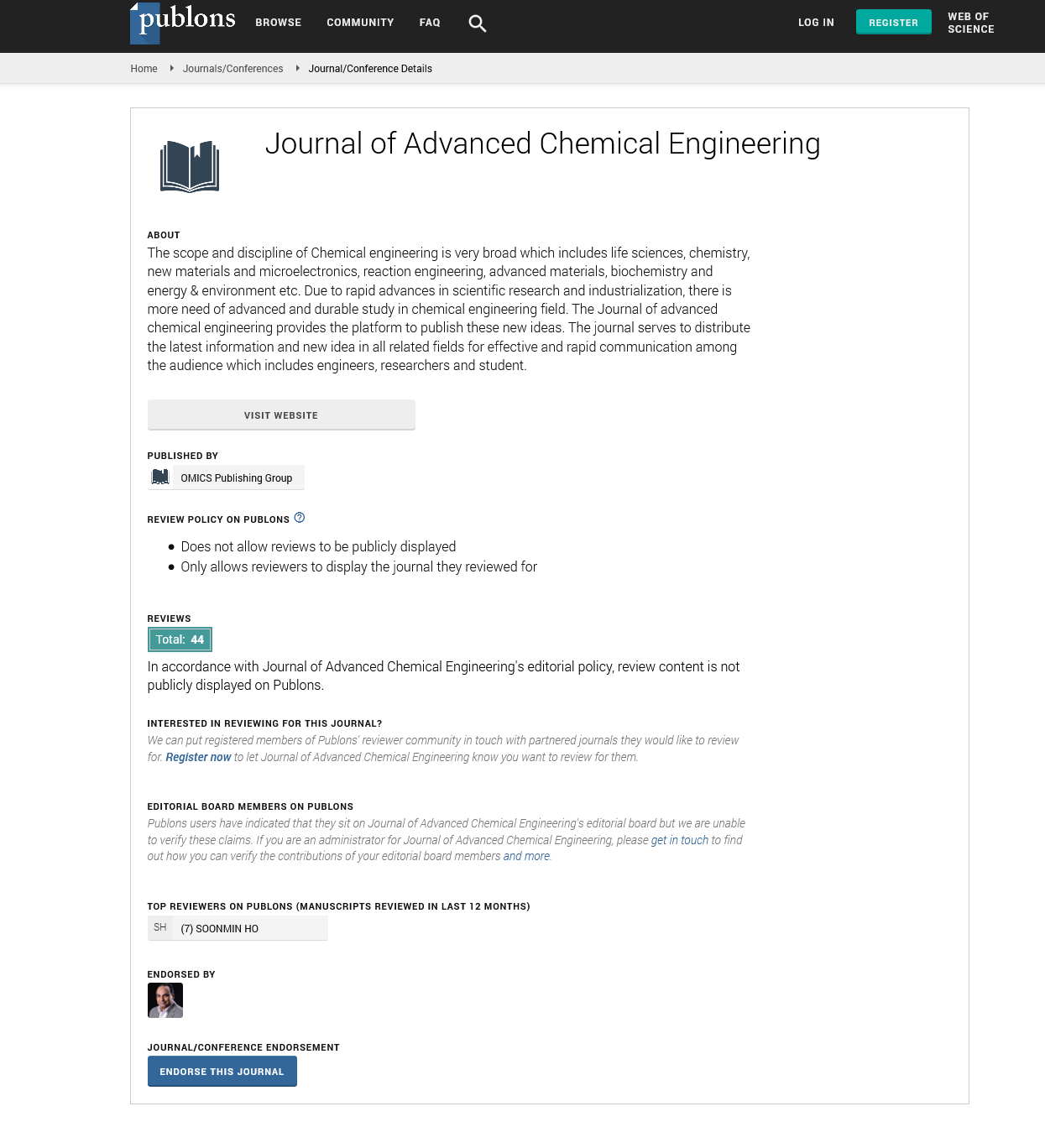Indexed In
- Open J Gate
- Genamics JournalSeek
- Smithers Rapra
- RefSeek
- Directory of Research Journal Indexing (DRJI)
- Hamdard University
- EBSCO A-Z
- OCLC- WorldCat
- Scholarsteer
- Publons
- Geneva Foundation for Medical Education and Research
- Google Scholar
Useful Links
Share This Page
Journal Flyer

Open Access Journals
- Agri and Aquaculture
- Biochemistry
- Bioinformatics & Systems Biology
- Business & Management
- Chemistry
- Clinical Sciences
- Engineering
- Food & Nutrition
- General Science
- Genetics & Molecular Biology
- Immunology & Microbiology
- Medical Sciences
- Neuroscience & Psychology
- Nursing & Health Care
- Pharmaceutical Sciences
Short Communication - (2025) Volume 15, Issue 2
Circular Economy Approaches in Chemical Engineering: Redefining Waste as Resource
Aisha Rahman*Received: 30-May-2025, Manuscript No. ACE-25-29812; Editor assigned: 02-Jun-2025, Pre QC No. ACE-25-29812 (PQ); Reviewed: 16-Jun-2025, QC No. ACE-25-29812; Revised: 23-Jun-2025, Manuscript No. ACE-25-29812 (R); Published: 30-Jun-2025, DOI: 10.35248/2090-4568.25.15.373
Description
The concept of a circular economy has emerged as a cornerstone of sustainable development, aiming to redefine the traditional linear model of "take, make, dispose" that dominates industrial production. For chemical engineering, this paradigm shift represents both an immense challenge and an unprecedented opportunity. By reimagining waste as a valuable resource, chemical engineers are uniquely positioned to design processes that minimize environmental impact, close resource loops, and foster long-term sustainability across industries. The adoption of circular economy principles requires systemic change, but the integration of chemical engineering expertise ensures that these transitions are grounded in scientific innovation and industrial practicality [1-4].
At its core, the circular economy seeks to maximize resource efficiency by extending the lifecycle of materials, products, and processes. This involves designing systems that prioritize reuse, recycling, remanufacturing, and recovery, rather than disposal. For chemical engineers, such a model demands new approaches to process design, materials selection, and energy integration. Advanced catalysis, bioprocessing, and waste valorization technologies are at the heart of this transition, enabling industries to reconfigure supply chains and reduce dependence on finite resources.
One of the most promising areas of circular economy in chemical engineering is waste-to-resource conversion. Industrial by-products such as COâ??, agricultural residues, and plastic waste are increasingly being recognized as feedstocks for new products. Chemical engineers have developed catalytic processes that transform COâ?? into valuable chemicals like methanol or polycarbonates, creating new revenue streams while reducing greenhouse gas emissions. Similarly, thermochemical and biochemical methods are employed to convert agricultural residues into biofuels, bioplastics, and specialty chemicals. Plastic recycling technologies, including chemical depolymerization, enable the recovery of monomers from post-consumer waste, allowing for the production of virgin-quality polymers without reliance on fossil fuels [5-8].
Energy efficiency and integration are also central to circular approaches. Industrial symbiosis, where the waste heat or by-products of one process become the inputs for another, exemplifies this principle. For instance, excess heat from steel manufacturing can be harnessed to drive nearby chemical processes, reducing overall energy demand. Chemical engineers are increasingly designing modular and integrated systems that ensure energy flows are optimized across entire industrial clusters. Such strategies not only minimize waste but also enhance economic resilience by reducing exposure to volatile resource prices.
Water management presents another vital dimension of circularity. Chemical engineers are developing closed-loop water systems where wastewater is treated, purified, and reused within industrial processes. Membrane filtration, advanced oxidation, and biological treatment methods enable industries to drastically reduce freshwater consumption while minimizing pollutant discharge. In regions facing acute water scarcity, these circular water systems are critical for maintaining industrial operations while safeguarding community needs and environmental health [9].
Circular economy principles also extend to product design. By incorporating life-cycle thinking into material selection and process engineering, chemical engineers help ensure that products are easier to recycle, disassemble, or repurpose at the end of their life. For example, designing biodegradable polymers or recyclable composites allows for more effective waste recovery and reduces environmental pollution. Similarly, adopting modular design principles in chemical plants enables easier upgrades, retrofits, and repurposing, extending the lifespan of capital infrastructure.
The transition to a circular economy is not without obstacles. Technical, economic, and regulatory barriers often hinder widespread adoption. Developing efficient recycling technologies that can handle heterogeneous waste streams remains a challenge. Economic models must evolve to account for the value of recovered resources and the externalities of waste disposal. Regulations need to encourage innovation while ensuring safety and environmental protection. Overcoming these challenges requires collaboration across stakeholders, with chemical engineers playing a central role in bridging the gap between scientific potential and industrial application [10].
Case studies around the world illustrate the growing momentum of circular economy initiatives. In Europe, the cement industry is substituting traditional fossil fuels with waste-derived fuels and incorporating industrial by-products such as fly ash into clinker production. In Asia, large-scale plastic recycling plants are converting mixed plastic waste into high-value chemicals using pyrolysis. In North America, carbon capture and utilization projects are transforming COâ?? emissions into building materials, fertilizers, and fuels. These examples underscore the transformative impact of chemical engineering innovations in enabling circular models across diverse industries.
References
- Badia-Valiente JD, Gil-Castell O. ChEngBoost: Vitaminised and gamified problem-based learning of chemical engineering bases in biotechnology. Educ Chem Eng. 2025.
- Inguva PK, Chadha D, Brechtelsbauer C, Heng JY, Matar OK, Shah U, et al. Integrating sustainability into chemical engineering education: Experiences from imperial college London. Clean Respons Consum. 2025. [CrossRef]
[Google Scholar][PubMed]
- Botha MC, Liebenberg SC, Conradie FH, van der Merwe MA. The Potential of the bland-altman method in chemical engineering. S Afr J Chem Eng. 2025.
- Vaquerizo L, Gil ID, Tututi-Avila S, Mato RB. Collaborative online international learning (coil) in chemical engineering: preparing students for multicultural and international work environments. Educ Chem Eng. 2025;53:26-36.
- Laul M, Galatro D. Causation in chemical engineering education: Application of machine learning in fault diagnosis. Educ Chem Eng. 2025.
- Landaverde-Alvarado C. Teamwork training and teaming skills to promote the development of professional competencies in chemical engineering students. Educ Chem Eng. 2025.
- Yu F, Lv J, Han H, Zhang Y, Zhang J. Application of AI teaching assistant to college education of principles of chemical engineering. Educ Chem Eng. 2025.
- Lopez B, Shao Y, Zavala VM. A graph-theoretic framework for analyzing and designing chemical engineering curricula. Comput Chem Eng. 2025.
- Zhou J, Xu F, Chang Z, Liu D, Li L, Cui J, et al. From lab to fab: A large language model for chemical engineering. Chin J Catal. 2025;73:159-173.
- Ronda A, Portillo E, Fernández LM, Arnaiz C, Luna-Galiano Y, Rodríguez-Galán M, et al. Strengths, Weaknesses, Opportunities and Threats (SWOT) analysis to improve teaching of the chemical and environmental engineering department in master's studies. Educ Chem Eng. 2025.
Citation: Rahman A (2025). Circular Economy Approaches in Chemical Engineering: Redefining Waste as Resource. Adv Chem Eng. 15:373.
Copyright: © 2025 Rahman A. This is an open-access article distributed under the terms of the Creative Commons Attribution License, which permits unrestricted use, distribution, and reproduction in any medium, provided the original author and source are credited.

